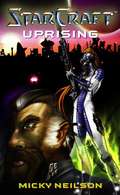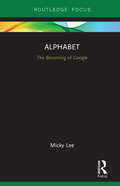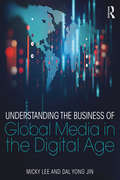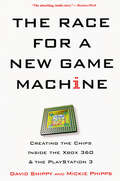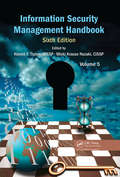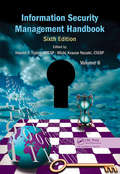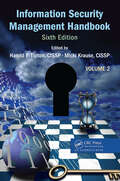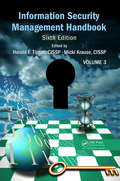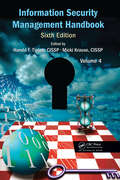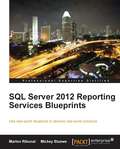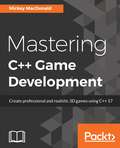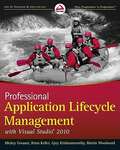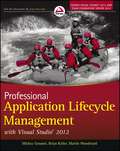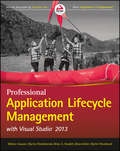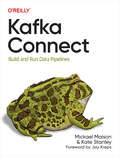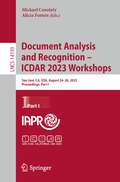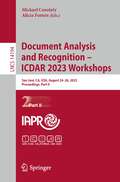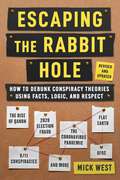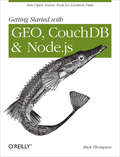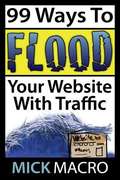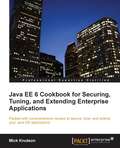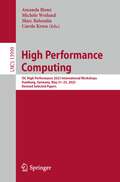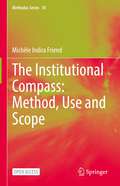- Table View
- List View
Starcraft: Uprising
by Micky NeilsonFar in the future, 60,000 light-years from Earth, a loose confederacy of Terran exiles are locked in battle with the enigmatic Protoss and the ruthless Zerg Swarm. Each species struggles to ensure its own survival among the stars in a war that will herald the beginning of mankind's greatest chapter -- or foretell its violent, bloody end. She is the Zerg Queen of Blades. Her name has become legend throughout the galaxy, and that legend is death for all who stand against her. Yet once, long ago, Sarah Kerrigan was human -- the unwilling subject of an insidious clandestine experiment. She was forced to serve as a merciless assassin for the Terran Confederacy until a twist of fate propelled her toward a destiny none could have foreseen. This is the untold tale of Kerrigan's shadowy origin. . . and the war that was fought for her very soul. An original tale of universal conflict set in the world of the award-winning, bestselling computer game from Blizzard Entertainment.
Alphabet: The Becoming of Google (Global Media Giants)
by Micky LeeGoogle is synonymous with searching, but in this innovative new research volume, Micky Lee explores how the Alphabet Corporation, now the parent company of Google, is more than just a search engine. Using a political economic approach, Lee draws on the concept of networks to investigate the growth of this key media player. The establishment of the parent company, Alphabet, shows the company is expanding to other industries from equity investment to self-driving cars. This book first examines this history of expansion, before delving into the economic, political, and cultural profiles of the corporation. Lee ultimately finds that what makes Google powerful is not one genius idea, but rather networks of people, places, and capital. Alphabet: The Becoming of Google is a compelling dive into the sometimes inscrutable world of Google, ideal for students, scholars, and researchers interested in the fields of digital media studies, the politics and economies of online media, and the history of the internet.
Understanding the Business of Global Media in the Digital Age
by Dal Yong Jin Micky LeeThis new introductory textbook provides students with the tools they need to understand the way digital technologies have transformed the global media business of the 21st century. Focusing on three main approaches – media economics, critical political economy, and production studies – the authors provide an empirically rich analysis of ownership, organizational structures and culture, business strategies, markets, networks of strategic alliances, and state policies as they relate to global media. Examples throughout involve both traditional and digital media and are taken from different regions and countries to illustrate how the media business is influenced by interconnected historical, political, economic, and social factors. In addition to introducing today’s convergent world of global media, the book gives readers a greater understanding of their own potential roles within the global media industries.
The Race For A New Game Machine
by David Shippy Mickie PhippsA fast-paced tell-all. . .one of the great business stories of our young century.--Steve Cherry, IEEE Spectrum Magazine The Xbox 360 and PlayStation 3 game systems have changed the face of home entertainment. But few know the amazing story inside the consoles--how David Shippy and his team of engineers at the Sony/Toshiba/IBM Design Center (STI) forged the tiny miracle at the core of it all: a revolutionary microprocessor chip that set a new paradigm in personal computing. At stake were the livelihoods--and sanity--of an unsung group of tireless visionaries. At war were the giants Microsoft and Sony. "Drama and secret deals. . . This is the real deal."--Bob Molyneaux, ChipBridge Here is a dazzling, behind-the-scenes account of life in the tech world, featuring memorable characters, high-level corporate intrigue, and cutthroat business dealings. It's a story that's never been told--until now. "The real story of a team of people tasked with doing the impossible."--John C. Beck, author of Got Game "Remarkable. . .fascinating."--Dean Takahashi, author of Opening the Xbox "The story of the whole effort to build the Cell."--The Wall Street Journal
Information Security Management Handbook, Volume 5
by Harold F. Tipton Micki Krause NozakiUpdated annually to keep up with the increasingly fast pace of change in the field, the Information Security Management Handbook is the single most comprehensive and up-to-date resource on information security (IS) and assurance. Facilitating the up-to-date understanding required of all IS professionals, the Information Security Management Handbook
Information Security Management Handbook, Volume 6
by Harold F. Tipton Cissp Micki Krause NozakiUpdated annually, the Information Security Management Handbook, Sixth Edition, Volume 6 is the most comprehensive and up-to-date reference available on information security and assurance. Bringing together the knowledge, skills, techniques, and tools required of IT security professionals, it facilitates the up-to-date understanding required to stay
Information Security Management Handbook, Volume 2
by Harold F. Tipton Micki KrauseA compilation of the fundamental knowledge, skills, techniques, and tools require by all security professionals, Information Security Handbook, Sixth Edition sets the standard on which all IT security programs and certifications are based. Considered the gold-standard reference of Information Security, Volume 2 includes coverage of each domain of t
Information Security Management Handbook, Volume 3 ((ISC)2 Press)
by Harold F. Tipton Micki KrauseEvery year, in response to new technologies and new laws in different countries and regions, there are changes to the fundamental knowledge, skills, techniques, and tools required by all IT security professionals. In step with the lightning-quick, increasingly fast pace of change in the technology field, the Information Security Management Handbook
Information Security Management Handbook, Volume 4
by Harold F. Tipton Micki KrauseEvery year, in response to advancements in technology and new laws in different countries and regions, there are many changes and updates to the body of knowledge required of IT security professionals. Updated annually to keep up with the increasingly fast pace of change in the field, the Information Security Management Handbook is the single most
SQL Server 2012 Reporting Services Blueprints
by Mickey Stuewe Marlon RibunalFollow the fictional John Kirkland through a series of real-world reporting challenges based on actual business conditions. Use his detailed blueprints to develop your own reports for every requirement.This book is for report developers, data analysts, and database administrators struggling to master the complex world of effective reporting in SQL Server 2012. Knowledge of how data sources and data sets work will greatly help readers to speed through the tutorials.
Mastering C++ Game Development: Create professional and realistic 3D games using C++ 17
by Mickey MacdonaldHigh-end game development with advanced C++ 17 programming techniques Key Features Make the best use of object-oriented capabilities of C++ 17 to develop high-end games Create reusable C++ 17 libraries and editor tools for your game Series of example projects demonstrating advanced techniques to build games of any genre Book Description Although many languages are now being used to develop games, C++ remains the standard for professional development. The majority of professional libraries and toolchains are still built using C++. The primary goal of this book is to teach you how to harness the power of the language and provide you with the ability to build high-quality games. To begin, you will be presented with, an overview of popular development methodologies, and a short guide to updated features of the C++ 17 standard. You will learn how to leverage existing libraries such as OpenGL and the STL (standard library) to build complex systems. Throughout the journey, you will also build a set of C++ 17 compatible libraries that can be reused in your own development projects. In the last half of the book, you will work with demos designed to introduce you to advanced rendering techniques, interactive physics, advanced AI techniques, and even multiplayer game concerns with modern networks. What you will learn Work and communicate effectively in the modern games industry Develop simple and advanced gameplay systems How to leverage the standard core C++ libraries Use modern real-time rendering techniques to achieve immersive 3D visuals Achieve a narrative-driven game experience using a variety of data management techniques Implement scripting using LUA Learn AI algorithms and concepts for handling motion, behavior, and decision making Implementation of the OpenGL, Bullet Physics, GLM, SteamVR and other common libraries Who this book is for This book is intended for aspiring game developers who are proficient in C++ 17 programming and are interested in developing professional games with C++.17
Professional Application Lifecycle Management with Visual Studio 2010
by Martin Woodward Mickey Gousset Brian Keller Ajoy KrishnamoorthyGet up to speed on Application Lifecycle Management (ALM) with Visual Studio 2010 through a combination of hands-on instruction and deep-dives.Microsoft has packed a lot of brand new testing and modeling tools into Visual Studio 2010, tools that previously were available only to Microsoft internal development teams. Developers will appreciate the focus on practical implementation techniques and best practices.A team of Microsoft insiders provides a nuts-and-bolts approach. This Wrox guide is designed as both a step-by-step guide and a reference for modeling, designing, and coordinating software development solutions at every level using Visual Studio 2010 and Visual Studio Team Foundation Server 2010.Visual Studio 2010 offers a complete lifecycle management system that covers modeling, testing, code analysis, collaboration, build and deployment tools.
Professional Application Lifecycle Management with Visual Studio 2012
by Martin Woodward Mickey Gousset Brian KellerThe authoritative and timely guide to ALM from Microsoft insiders and MVPs Focused on the latest release of Visual Studio, this edition shows you how to use the Application Lifecycle Management (ALM) capabilities of Visual Studio 2012 to streamline software design, development, and testing. Divided into six main parts, this timely and authoritative title covers Team Foundation Server, stakeholder engagement, project management, architecture, software development, and testing. Whether serving as a step-by-step guide or a reference for designing software solutions, this book offers a nuts-and-bolts approach to using Microsoft's flagship development tools to solve real-world challenges throughout the application lifecycle. Coverage includes: INTRODUCTION TO APPLICATION LIFECYCLE MANAGEMENT WITH VISUAL STUDIO INTRODUCTION TO TEAM FOUNDATION SERVER TEAM FOUNDATION VERSION CONTROL TEAM FOUNDATION BUILD COMMON TEAM FOUNDATION SERVER INTRODUCTION TO BUILDING STORYBOARDING CAPTURING STAKEHOLDER FEEDBACK AGILE PLANNING AND TRACKING INTRODUCTION TO SOFTWARE ARCHITECTURE TOP-DOWN DESIGN WITH USE CASE ANALYZING APPLICATIONS USING USING LAYER DIAGRAMS TO MODEL INTRODUCTION TO SOFTWARE DEVELOPMENT UNIT TESTING CODE ANALYSIS, CODE METRICS PROFILING AND PERFORMANCE DEBUGGING WITH INTELLITRACE INTRODUCTION TO SOFTWARE TESTING MANUAL TESTING CODED USER INTERFACE TESTING WEB PERFORMANCE AND LOAD TESTING LAB MANAGEMENT Professional Application Lifecycle Management with Visual Studio 2012 offers a thoroughly revised and updated edition of the leading reference book on ALM.
Professional Application Lifecycle Management with Visual Studio 2013
by Martin Woodward Mickey Gousset Brian Keller Brian A. Randell Martin HinshelwoodRamp up your software development with this comprehensive resourceMicrosoft's Application Lifecycle Management (ALM) makes software development easier and now features support for iOS, MacOS, Android, and Java development. If you are an application developer, some of the important factors you undoubtedly consider in selecting development frameworks and tools include agility, seamless collaboration capabilities, flexibility, and ease of use. Microsoft's ALM suite of productivity tools includes new functionality and extensibility that are sure to grab your attention. Professional Application Lifecycle Management with Visual Studio 2013 provides in-depth coverage of these new capabilities. Authors Mickey Gousset, Martin Hinshelwood, Brian A. Randell, Brian Keller, and Martin Woodward are Visual Studio and ALM experts, and their hands-on approach makes adopting new ALM functionality easy.Streamline software design and deployment with Microsoft tools and methodologiesGain a practical overview of ALM with step-by-step guides and reference materialCase studies illustrate specific functionality and provide in-depth instructionUse new capabilities to support iOS, MacOS, Android and Java developmentDiscover this comprehensive solution for modeling, designing, and coordinating enterprise software deploymentsOver 100 pages of new content, forward-compatible with new product releasesProfessional Application Lifecycle Management with Visual Studio 2013 provides a complete framework for using ALM to streamline software design and deployment processes using well-developed Microsoft tools and methodologies. Professional Application Lifecycle Management with Visual Studio 2013 is your guide to make use of newly-available ALM features to take your enterprise software development to the next level.
Kafka Connect: Build and Run Data Pipelines
by Kate Stanley Mickael MaisonUsed by more than 80% of Fortune 100 companies, Apache Kafka has become the de facto event streaming platform. Kafka Connect is a key component of Kafka that lets you flow data between your existing systems and Kafka to process data in real time.With this practical guide, authors Mickael Maison and Kate Stanley show data engineers, site reliability engineers, and application developers how to build data pipelines between Kafka clusters and a variety of data sources and sinks. Kafka Connect allows you to quickly adopt Kafka by tapping into existing data and enabling many advanced use cases. No matter where you are in your event streaming journey, Kafka Connect is the ideal tool for building a modern data pipeline.Learn Kafka Connect's capabilities, main concepts, and terminologyDesign data and event streaming pipelines that use Kafka ConnectConfigure and operate Kafka Connect environments at scaleDeploy secured and highly available Kafka Connect clustersBuild sink and source connectors and single message transforms and converters
Document Analysis and Recognition – ICDAR 2023 Workshops: San José, CA, USA, August 24–26, 2023, Proceedings, Part I (Lecture Notes in Computer Science #14193)
by Alicia Fornés Mickael CoustatyThis two-volume set LNCS 14193-14194 constitutes the proceedings of International Workshops co-located with the 17th International Conference on Document Analysis and Recognition, ICDAR 2023, held in San José, CA, USA, during August 21–26, 2023. The total of 43 regular papers presented in this book were carefully selected from 60 submissions. Part I contains 22 regular papers that stem from the following workshops: ICDAR 2023 Workshop on Computational Paleography (IWCP); ICDAR 2023 Workshop on Camera-Based Document Analysis and Recognition (CBDAR); ICDAR 2023 International Workshop on Graphics Recognition (GREC); ICDAR 2023 Workshop on Automatically Domain-Adapted and Personalized Document Analysis (ADAPDA); Part II contains 21 regular papers that stem from the following workshops: ICDAR 2023 Workshop on Machine Vision and NLP for Document Analysis (VINALDO); ICDAR 2023 International Workshop on Machine Learning (WML).
Document Analysis and Recognition – ICDAR 2023 Workshops: San José, CA, USA, August 24–26, 2023, Proceedings, Part II (Lecture Notes in Computer Science #14194)
by Alicia Fornés Mickael CoustatyThis two-volume set LNCS 14193-14194 constitutes the proceedings of International Workshops co-located with the 17th International Conference on Document Analysis and Recognition, ICDAR 2023, held in San José, CA, USA, during August 21–26, 2023. The total of 43 regular papers presented in this book were carefully selected from 60 submissions. Part I contains 22 regular papers that stem from the following workshops: ICDAR 2023 Workshop on Computational Paleography (IWCP); ICDAR 2023 Workshop on Camera-Based Document Analysis and Recognition (CBDAR); ICDAR 2023 International Workshop on Graphics Recognition (GREC); ICDAR 2023 Workshop on Automatically Domain-Adapted and Personalized Document Analysis (ADAPDA); Part II contains 21 regular papers that stem from the following workshops: ICDAR 2023 Workshop on Machine Vision and NLP for Document Analysis (VINALDO); ICDAR 2023 International Workshop on Machine Learning (WML).
Escaping the Rabbit Hole: How to Debunk Conspiracy Theories Using Facts, Logic, and Respect (Revised and Updated - Includes Information about 2020 Election Fraud, The Coronavirus Pandemic, The Rise of QAnon, and UFOs)
by Mick WestRevised and updated for the first time in 2023—Now includes strategies for debunking conspiracies regarding the coronavirus pandemic, election fraud, QAnon, UFOs, and more. The Earth is flat, the World Trade Center collapse was a controlled demolition, planes are spraying poison to control the weather, and actors faked the Sandy Hook massacre. All these claims are bunk: falsehoods, mistakes, and in some cases, outright lies. But many people passionately believe one or more of these conspiracy theories. They consume countless books and videos, join like-minded online communities, try to convert those around them, and even, on occasion, alienate their own friends and family. Why is this, and how can you help people, especially those closest to you, break free from the downward spiral of conspiracy thinking? In Escaping the Rabbit Hole, author Mick West shares over a decade&’s worth of knowledge and experience investigating and debunking false conspiracy theories through his forum, MetaBunk.org, and sets forth a practical guide to helping friends and loved ones recognize these theories for what they really are. Perhaps counter-intuitively, the most successful approaches to helping individuals escape a rabbit hole aren&’t comprised of simply explaining why they are wrong; rather, West&’s tried-and-tested approach emphasizes clear communication based on mutual respect, honesty, openness, and patience. West puts his debunking techniques and best practices to the test with the most popular false conspiracy theories today (Chemtrails, The Coronavirus Pandemic, 9/11 Controlled Demolition, Election Fraud, False Flags, Flat Earth, The Rising of QAnon, and UFOs)—providing road maps to help you to understand your friend and help them escape the rabbit hole. These are accompanied by real-life case studies of individuals who, with help, were able to break free from conspiracism. With sections on: the wide spectrum of conspiracy theoriesavoiding the &“shill&” labelpsychological factors and other complications(and concluding with) a look at the future of debunking Mick West has put forth a conclusive, well-researched, practical reference on why people fall down the conspiracy theory rabbit hole and how you can help them escape.
Getting Started with GEO, CouchDB, and Node.js: New Open Source Tools for Location Data
by Mick ThompsonToday's mobile devices have GPS and standard APIs to give you access to coordinates—but what can you do with that data? With this concise book, application developers learn how to work with location data quickly and easily, using Node.js, CouchDB, and other open source tools and libraries.Node.js makes it simple to run event code on the Web, and the CouchDB document-oriented database lets you store location data and perform complex queries on it quickly. You'll learn how to get started with these tools, and then use them together to build an example project called MapChat, using HTML and JavaScript code samples.Learn how to serve dynamic content with Node.js, and use its asynchronous IO to handle several requests at onceBecome familiar with GeoJSON, Geohash, and the Geospatial Data Abstraction Library (GDAL) for working with spatial dataBuild geospatial indexes using the GeoCouch branch of CouchDBCombine these tools to build a project that lets users post real-time chat messages tagged with their current map location
99 Ways To Flood Your Website With Traffic
by Mick MacroThis book has helped thousands of people flood massive amounts of traffic into their websites, blogs, videos, and many other pages online, and will help you too. If you have ever wanted a complete list of every traffic strategy you need to get massive amounts of website traffic, 99 Ways To Flood Your Website With Traffic is the book for you. Not only do you get to hear about specific websites and strategies, but you also learn how to combine certain strategies to maximize your results. When you start putting all of these website traffic tips into one big traffic strategy of your own, you are able to drive traffic to your websites literally whenever you want. Discover: - How to maximize viral sharing of your sites and pages. - Easy scripts that give you free traffic every single day. - How to maximize free giveaways for success. - Free promotion and advertising sites that give you free site traffic. - Short-tail, long-tail and super-long-tail keywords, and what they mean. - Audio, video and other multimedia to add that keeps visitors wanting more. - How to really get online traffic from articles and other Web 2.0 websites. ...as well as tons of more topics that will bring you traffic! Start Flooding Traffic Into Your Website Starting TODAY: This book was written to give you an overview of the different types of strategies that work well, and focuses more on coming up with the best strategy for your websites and blogs, and not just what worked on one guy's blog years ago. Most of these strategies are core tactics that can be used for years to come. This book was built for you to be able to pick and choose your favorite strategies, come up with your own "super list", and start implementing these strategies immediately. You will go from A to Z with all the types of traffic strategies that work online, and this book takes you through the steps to taking action. Buy this book and start getting the traffic that your websites and blogs deserve.
Java EE6 Cookbook for securing, tuning, and extending enterprise applications
by Mick KnutsonThis book is part of Packt's Cookbook series. A Packt Cookbook contains step-by-step recipes for solutions to the most important problems you face when working with a topic. This book is aimed at Java developers and programmers who want to secure, tune and, extend their Java EE applications.
High Performance Computing: ISC High Performance 2023 International Workshops, Hamburg, Germany, May 21–25, 2023, Revised Selected Papers (Lecture Notes in Computer Science #13999)
by Michèle Weiland Amanda Bienz Marc Baboulin Carola KruseThis volume constitutes the papers of several workshops which were held in conjunction with the 38th International Conference on High Performance Computing, ISC High Performance 2023, held in Hamburg, Germany, during May 21–25, 2023. The 49 revised full papers presented in this book were carefully reviewed and selected from 70 submissions. ISC High Performance 2023 presents the following workshops: 2nd International Workshop on Malleability Techniques Applications in High-Performance Computing (HPCMALL)18th Workshop on Virtualization in High-Performance Cloud Computing (VHPC 23)HPC I/O in the Data Center (HPC IODC)Workshop on Converged Computing of Cloud, HPC, and Edge (WOCC’23)7th International Workshop on In Situ Visualization (WOIV’23)Workshop on Monitoring and Operational Data Analytics (MODA23)2nd Workshop on Communication, I/O, and Storage at Scale on Next-Generation Platforms: Scalable InfrastructuresFirst International Workshop on RISC-V for HPCSecond Combined Workshop on Interactive and Urgent Supercomputing (CWIUS)HPC on Heterogeneous Hardware (H3)
The Institutional Compass: Method, Use and Scope (Methodos Series #18)
by Michèle Indira FriendThis open access book presents a new generation multi-criteria, multi-stake holder, decision aide, called an "institutional compass". Based on hard data, the compass tells us what quality-direction we are heading in as an institution, region, system or organisation. The quality is not chosen from the usual scalar qualities of: good, neutral and bad. Instead, it is a quality chosen between: harmony, discipline and excitement. None is good in and of itself. We need some of each. The compass marks a new generation in four respects. 1. The representation of the data is intuitive and simple to understand, and therefore can be used to communicate and justify policy decisions. 2. Any data can be included, i.e., none is excluded. This makes the compass tailored to particular situations, voices and contexts. 3. The data includes different time horizons and different types of value: monetary, use, social, sentimental, religious, intrinsic, existential... 4. The process of compass construction can be made inclusive at several junctions. An institutional compass can be extended to evaluate products, add normativity to a systems analysis, reflect world-views such as that of ecological economists or function as an accounting system to manage scarce resources. There are four parts to the book. The first part introduces the general ideas behind the compass. In the second part, the author presents the method for constructing the compass. This includes data collection, data analysis and a mathematical formula to aggregate the data into a single holistic reading. In the third part, the author extends the methodology: to incorporate it into systems science, adding a normative and quality-direction dimension, to use it as a non-linear accounting method and more thoroughly to reflect the philosophy of ecological economists to give a real measure of sustainability. In the fourth part, we see three case studies: one for the World Health Organisation, a second is the use of the compass to label products in a shop and the third is as a regional compass for Hauts-de-France. The book ends with philosophical conclusions. Throughout the book, we see tight arguments, refreshing ideas and a thorough treatment of objectivity in decision making.
Un día cualquera en 2100
by Michio Kaku¿Nunca te has preguntado cómo será el siglo XXII? ¿Qué pasará cuando la gente corriente despierte el 1 de enero de 2100? Michio Kaku te ofrece un ensayo relatado que te dará unas cuantas pistas sobre lo que será la vida en la Tierra (y fuera de ella) el próximo siglo. «La humanidad es como un ser cuyos brazos se alargan hasta tocar las estrellas, y cuyos pies están atascados en el barro. Por una parte, este siglo verá una nueva era de exploración espacial robótica, porque enviaremos satélites cuya misión será localizar en el espacio planetas gemelos de la Tierra, explorar las lunas de Júpiter, e incluso tomar imágenes del propio big bang. Sin embargo, la exploración del espacio exterior mediante naves tripuladas, que ha cautivado a muchas generaciones de soñadores y visionarios, será causa de algunos disgustos.»
Un día cualquiera en 2100
by Michio Kaku¿Nunca te has preguntado cómo será el siglo XXII? ¿Qué pasará cuando la gente corriente despierte el 1 de enero de 2100? Michio Kaku te ofrece un ensayo relatado que te dará unas cuantas pistas sobre lo que será la vida en la Tierra (y fuera de ella) el próximo siglo. «La humanidad es como un ser cuyos brazos se alargan hasta tocar las estrellas, y cuyos pies están atascados en el barro. Por una parte, este siglo verá una nueva era de exploración espacial robótica, porque enviaremos satélites cuya misión será localizar en el espacio planetas gemelos de la Tierra, explorar las lunas de Júpiter, e incluso tomar imágenes del propio big bang. Sin embargo, la exploración del espacio exterior mediante naves tripuladas, que ha cautivado a muchas generaciones de soñadores y visionarios, será causa de algunos disgustos.»
